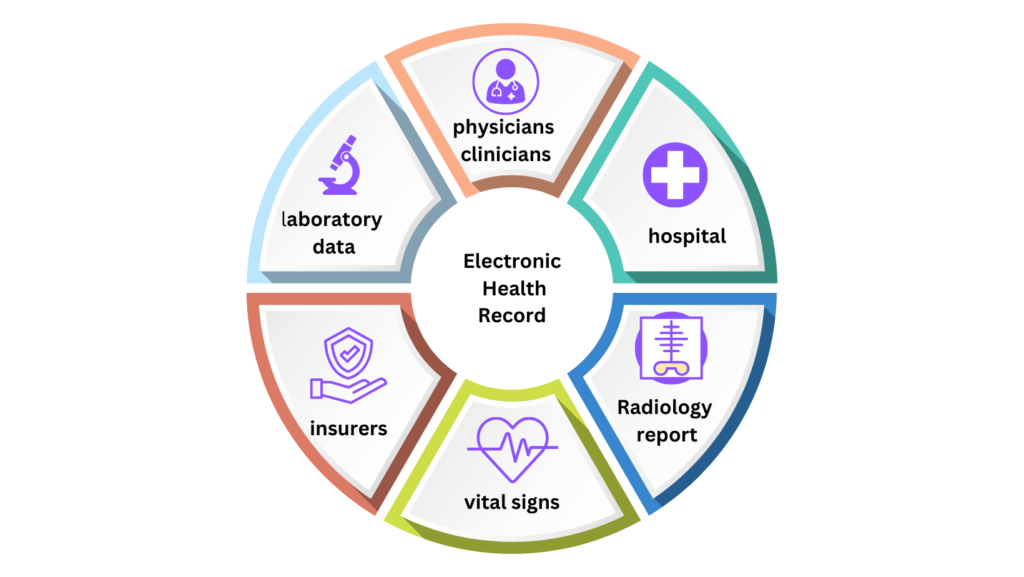Advancements in the healthcare industry, such as the introduction of telehealth, customer relationship management (CRM) systems, and the evolution of electronic health record (EHR) software, have a substantial impact on the overall ecosystem. This positive influence reaches multiple stakeholders, providing advantages not just to patients and healthcare practitioners but also to entrepreneurs engaged in the establishment of these EHR platforms.
Continuing further in the article, we will explore the advantages of EHR systems, in addition to operational aspects such as the various types of EHR systems, the functioning of EHR, the process of constructing an EHR system, key features, and ultimately, the cost associated with EHR software development.
What is an EHR system?

At the focal point of our discussion today lies the development of Electronic Health Records. An electronic health record is a fully digitized software housing comprehensive information concerning patients’ health. This typically encompasses:
- Medical history
- Vaccination details
- Test results
- Vital signs
- Allergies
- Medications
- Lab data
- Progress notes
- Insurance information, etc.
When discussing the concept of an EHR system, another term that commonly arises as an alternative is EMR. Although these terms are frequently used interchangeably, there exists a substantial distinction between electronic health records and electronic medical records.
Types of EHR systems
Within the healthcare realm, two fundamental types of electronic health record systems exist, both essential in addressing the question of how to construct an EHR system.
Physician hosted
This EHR type involves hosting data on the physician’s servers. Within this category, the physician assumes responsibility for purchasing the necessary hardware and software, as well as maintaining them.
Physician hosted
In these EHRs, the server is located outside the physician’s office. This implies that the physician is not accountable for storing and managing patients’ data. The advantage of this EHR type is that healthcare practitioners can concentrate solely on collecting information without being concerned about managing the IT system.
Remotely hosted
In these EHRs, the server is located outside the physician’s office. This implies that the physician is not accountable for storing and managing patients’ data. The advantage of this EHR type is that healthcare practitioners can concentrate solely on collecting information without being concerned about managing the IT system.
The benefits of the EHR system for primary stakeholders
Now that you have gained some understanding of the EHR development concept, let’s delve into the benefits it provides for the three primary stakeholders: businesses, hospitals, and patients.
EHR software development benefits for businesses
Scope for new opportunities
The EHR market operates on a customized approach rather than a ‘one size fits all’ model. Each healthcare organization, regardless of its size and location, possesses distinct EHR software requirements. This indicates a continual potential for innovation in the form of new business models.
Multiple monetization options
Just like any other software, EHRs present diverse monetization models, spanning subscriptions, free software with paid features, and pay-per-use. This broad spectrum of monetization choices renders investing in EHR system development exceptionally profitable.
EHR system development benefits for hospitals
Better operational efficiency
Irrespective of the specific EHR systems selected, they all share the advantage of eliminating the necessity to handle paperwork such as bills and reports. Every piece of patient information is readily accessible within the system within seconds. The degree of digitalization promised by EHR also simplifies processes for doctors, allowing them to receive data from the lab, prescribe medication, and monitor patients’ medical history effortlessly.
Lowered risk of medical errors
The electronic health record software contains comprehensive patient information, offering medical insights driven by data analytics. This provides healthcare providers with valuable information about incorrect dosages, adverse reactions, and potential outcomes of drug interactions. The result of this is a reduction in the risk of malpractice and medical issues.
High level of security
A meticulously designed EHR system incorporates various security measures, including automated session termination, digital signatures, encryption, and multi-factor authentication. With this comprehensive security infrastructure, the risk of software hacking is minimized to zero.
Lowered costs
While EHR development and implementation can initially incur significant expenses, the long-term benefits, including reduced transcription costs, cost-effective patient record storage, and simplified claims management, contribute to making it a financially rewarding investment for hospitals.
Improved patient-doctor interactions
EHR applications play a crucial role in enhancing patient interactions and experiences with healthcare providers and facilities. Firstly, they streamline and expedite administrative processes related to obtaining doctor’s appointments, hospitalization formalities, and more. Secondly, patients can access their health records, review clinician’s notes, and engage with their doctors electronically.
EHR software development benefits for patients
Easy access to key information
Each variant of electronic health record systems includes a patient-friendly platform that provides users access to their medical records, test results, and the necessary documents for insurance claims or scheduling further appointments with doctors.
Elimination of test duplications
In healthcare systems without access to patients’ medical records, individuals often undergo redundant testing. The implementation of robust electronic health record software eradicates this necessity, as healthcare professionals have comprehensive test details and results readily available in their systems.
The must-have EHR software requirements
1. Document management
The core objective of developing EHR applications is to enhance patient care through the provision of a user-friendly documentation tool. It should facilitate easy uploading of documents in various formats, including images, text, and DICOM (the format for MRI and CT images), for both patients and doctors.
2. Patient details
The EHR system typically includes personal information about patients such as their full name, address, diagnosis, test results, list of prescribed medicines, and other crucial details that provide insights into the patient’s health.
3. Prescription management
Through the e-prescribing feature, physicians can remotely prescribe medications to patients, accessing their medical data to ensure there is no drug incompatibility. Simultaneously, patients can monitor their medication history.
4. Data access control
An EHR system must incorporate multiple data access control mechanisms. A fundamental principle our EHR developers consistently prioritize is ensuring that individuals at different levels, for instance, nurses and doctors, do not have access to the same data.
5. Appointment scheduling
Utilizing the electronic health record software, patients can promptly schedule appointments with their doctors. Conversely, doctors have access to a dashboard where they can view appointments alongside the respective patient details.
6. Reporting
Reporting is a pivotal element in addressing the question of EHR development. For healthcare practitioners, it provides a comprehensive overview encompassing patients’ demographic data, treatments administered, and the success rate of treatment, among other factors. Meanwhile, for patients, it presents a visual representation of their treatment progress, upcoming appointments, and related information.
7. Labs integration
The integration of EHR with test labs ensures rapid data exchange and expedited decision-making. Adding to its efficiency is the direct transmission of test results to the respective apps, facilitating easy access for both patients and doctors to take prompt action.
8. Invoicing
In every healthcare facility, dealing with invoices, claims, denials, and treatment-related payments is a standard practice. The EHR system simplifies this process by automating the invoicing workflow. Moreover, many of these systems now incorporate payment features, enabling patients to directly make payments for their treatments.
The technology and team required for EHR development
The effectiveness of EHR applications hinges on two key factors – the feature set and the resources, including technology and the team, supporting them. Having examined the first aspect of success, let’s delve into the next.
The ideal team structure that you need to invest in for building your EHR system –
- 3 web developers – 2 frontend and 1 backend
- 1 Android EHR developer
- 1 iOS EHR developer
- 2 QA experts
- 1 project manager
Having explored the intricate operational aspects of constructing an EHR system, let’s now delve into the steps that contribute to the development of EHR software.
How to build an EHR system?
The stages of development that your EHR software development company is likely to follow for creating an electronic health record system include:
Validation of idea
Before embarking on the development of a customized EHR solution, the software agency will assess its feasibility and market fit. They will engage in discussions with you to comprehend your vision, and requirements, and analyze your competitors to determine distinctive features that would set your solution apart.
EHR prototype
The process is initiated by compiling a list of features, settling on the technology stack, and finalizing the team assigned to the project.
Subsequently, a prototype is developed, representing a close approximation of the envisioned appearance and functionality of the software.
Design, development, and testing
Upon receiving approval for the EHR software prototype, we proceed with the final design phase. During this stage, we generate wireframes and user journeys that encompass the designs to be featured in the ultimate EHR system.
After this, we undertake the development of the EHR system, incorporating the necessary features, integrating technologies such as AI, IoT, or Blockchain, and implementing security elements. At Digitto IT Services, we emphasize a milestone approach in the development process, breaking down the stages into multiple agile sprints. This approach ensures expedited delivery and real-time quality checks for each module.
Launch and maintenance
After constructing and testing the EHR system, we proceed with the software launch, either by integrating it into the existing system or by introducing it as a completely new software. In this phase, the expertise of deployment specialists is crucial in ensuring a smooth launch process.
Things to consider when building an EHR software
Although the stages of EHR system creation are straightforward, the process can become intricate due to the numerous elements it encompasses. Let’s delve into some of these considerations.
Work on the mobile version of the EHR
While having a web version of the software is essential, introducing a mobile EHR makes it convenient for patients and doctors to stay connected while on the move. Additionally, the mobile EHR enhances patient engagement in their treatment journey.
Data migration
When transitioning from your existing EHR system to a new one, it is crucial to migrate all essential information into the new software. During the migration process, adopting a milestone approach is essential, where data is transferred in phases to ensure a seamless transition.
Track the EHR system performance
Ensuring the ongoing success of an Electronic Health Record (EHR) system involves assessing its performance. At Digiatto IT Services we evaluate the system’s usability by measuring various factors such as-
- Assessing the user-friendliness of the EHR system for physicians.
- ROI calculations
- Evaluating the standard of care by considering feedback from patients.
- Supervising and ensuring the excellence of the EHR system.
By now, you likely have a solid understanding of how to construct an EHR system for your healthcare business. Let’s now delve into a critical aspect that directly affects you as an entrepreneur or business leader – the cost of developing EHR software.
The cost of EHR software development
The expense associated with the development of Electronic Health Record (EHR) software can vary substantially, influenced by factors like the incorporated features, chosen technology stack, project complexity, and the size of the development team. It’s crucial to emphasize that these approximations are general, and the actual costs might deviate based on specific project demands and prevailing market conditions. Here is an analysis of potential costs:
Features:
– Basic Features: Patient registration, appointment scheduling, and basic EHR functionalities.
– Intermediate Features: Electronic prescribing, laboratory result integration, and billing.
– Advanced Features: Decision support systems, telemedicine integration, and interoperability with other healthcare systems.
Technology Stack:
– Front-end Development: The design of the user interface and user experience is a contributing factor to the overall cost.
– Back-end Development: The server-side logic, database management, and data processing.
– Database: The choice of database technology can impact costs.
– Integration: Costs associated with integrating the EHR system with other healthcare systems and third-party services.
Team Size:
– Project Manager: Tasked with supervising the development process and team management.
– Developers: Front-end, back-end, and database developers.
– QA Engineers: Testing the software to ensure it meets quality standards.
– UI/UX Designers: Designing the user interface and experience.
– System Architects: Planning and designing the overall system architecture.
Other Costs:
– Regulatory Compliance: Ensuring the software complies with healthcare regulations.
– Security: Implementing robust security measures to protect patient data.
– Maintenance and Support: Ongoing maintenance, updates, and user support.
Hourly Rates:
– Development rates can vary based on the geographical location of the development team. Rates in North America and Western Europe are generally higher than in other regions.
Estimated Costs:
– Basic EHR System: $50,000 – $80,000
– Intermediate EHR System: $80,000 – $1,30000
– Advanced EHR System: $1 Lakh and above
These estimates are very rough and should be used as a starting point. It’s crucial to engage with a software development team, discuss your specific requirements, and obtain a detailed project proposal to get a more accurate estimate for your EHR software development project.
How can Digiatto IT Services help with your EHR project?
Digiatto IT Services has played a pivotal role in conceptualizing and developing more than 30 EHRs, catering to both hospital and patient interfaces. Our team of developers possesses a comprehensive understanding of healthcare compliances, ensuring the creation of efficient EHR systems that comply with all regulations. What sets us apart in the healthcare software domain is our ability to incorporate cutting-edge technologies and insights into crafting forward-thinking EHR software.
With a perfect amalgamation of skills and technological acumen, we are well-equipped to assist you in constructing and deploying an effective EHR within your healthcare system. We ensure high security, scalability, and interoperability. Simply reach out to our team of healthcare experts to kickstart your EHR journey.
FAQs related to EHR development
How would you define EHR software?
An electronic health record is a fully digitized software housing comprehensive information about patient’s health, including details such as medical history, age, vaccination records, and a list of prescribed medications.
What is the cost associated with developing an EHR system?
There isn’t a singular fixed answer to this. Depending on factors like feature sets, technology stack, and the number of platforms, the cost can vary between $40,000 to $100,000.
What factors should I consider when constructing an EHR?
Several elements influence the ongoing success of an EHR system, including factors such as compliance readiness, the presence of a mobile version, and effective data migration. For a comprehensive understanding of these elements, please contact our healthcare developers.



Pingback: A Complete Guide to Healthcare Compliances - HealthSaaSPro
Pingback: Legacy Systems in Healthcare - HealthSaaSPro
Pingback: Top 10 Best Medical Billing Software Of 2024 - HealthSaaSPro
Pingback: Transform Your Healthcare Business with Digital Payments - HealthSaaSPro
Pingback: Healthcare Business Startup Ideas for Aspiring Entrepreneurs - HealthSaaSPro
Pingback: List of Medical Billing Software in US - HealthSaaSPro